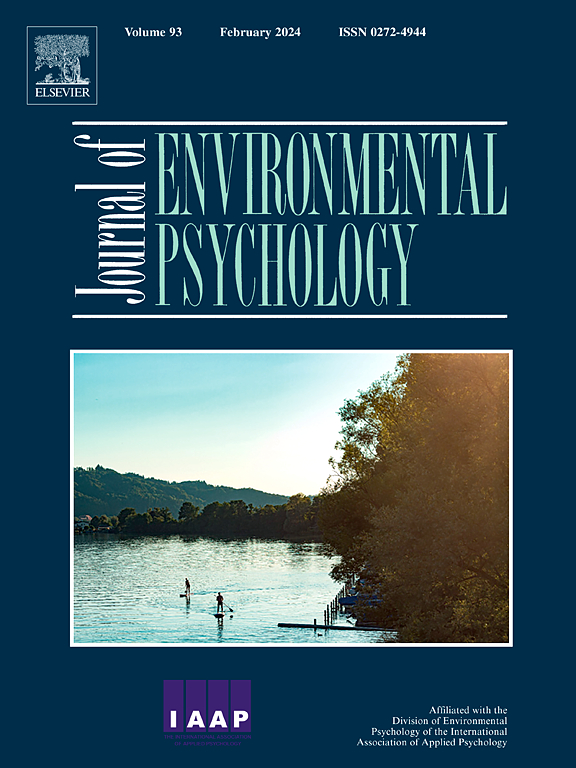研究户外自然环境与建筑环境的可承受性
IF 7
1区 心理学
Q1 ENVIRONMENTAL STUDIES
引用次数: 0
摘要
以往的心理学研究从减轻压力和恢复注意力的角度研究了大自然的益处,而目前的研究则侧重于自然环境和人造环境能唤起哪些行动的可能性。在对一种新颖的自我管理程序进行试点测试,以了解人们在户外建筑或自然环境中行走后觉得自己 "可以做什么 "之后,我们又进行了两项研究,以测试步行者在户外建筑或自然环境中行走时发现的行动可能性(即可负担性)的定量差异。一项自然研究涉及社区参与者,他们是在社区同一地区的 12 个建筑或自然景点中的一个现场招募的。一项现场实验涉及大学生,他们被随机分配到四个地点(森林或草地,或一个小镇市中心的两个区域之一)中的一个。在对 "我可以...... "这一提示语所做的回答中,没有发现自然景观与人造景观在数量上有可靠的差异。然而,在实地实验中,在建筑场地而非自然场地的参与者产生了更多的动词和社会内容,以及更多的总词数。在实验中,在自然场地行走的参与者比在人造场地行走的参与者在积极情绪方面有更大的改善。本文章由计算机程序翻译,如有差异,请以英文原文为准。
Examining affordances of outdoor natural versus built environments
Whereas previous psychological research has examined the benefits of nature from a stress-reduction and attention-restoration perspective, the current studies focus on what possibilities for action are evoked by natural versus built environments. After a study pilot-testing a novel self-administration procedure for soliciting what individuals feel they “could do” in a built or natural outdoor site after walking in it, two studies were conducted to test quantitative differences in the action possibilities (i.e., affordances) that walkers detected when moving through a built or a natural site. A naturalistic study involved community participants who were recruited on-site at one of 12 built or natural sites within the same region of a community. A field experiment involved college students randomly assigned to walk one of four sites (forest or meadow, or one of two areas within the downtown of a small town). No reliable differences were detected in number of responses to the prompt “I could …” completed by participants as a function of natural versus built sites. However, in the field experiment, participants in built rather than natural sites generated more verb and social content, and more total words. In the experiment, participants who walked natural sites had more improvement in positive affect than those who walked built sites.
求助全文
通过发布文献求助,成功后即可免费获取论文全文。
去求助
来源期刊

Journal of Environmental Psychology
Multiple-
CiteScore
10.60
自引率
8.70%
发文量
140
审稿时长
62 days
期刊介绍:
The Journal of Environmental Psychology is the premier journal in the field, serving individuals in a wide range of disciplines who have an interest in the scientific study of the transactions and interrelationships between people and their surroundings (including built, social, natural and virtual environments, the use and abuse of nature and natural resources, and sustainability-related behavior). The journal publishes internationally contributed empirical studies and reviews of research on these topics that advance new insights. As an important forum for the field, the journal publishes some of the most influential papers in the discipline that reflect the scientific development of environmental psychology. Contributions on theoretical, methodological, and practical aspects of all human-environment interactions are welcome, along with innovative or interdisciplinary approaches that have a psychological emphasis. Research areas include: •Psychological and behavioral aspects of people and nature •Cognitive mapping, spatial cognition and wayfinding •Ecological consequences of human actions •Theories of place, place attachment, and place identity •Environmental risks and hazards: perception, behavior, and management •Perception and evaluation of buildings and natural landscapes •Effects of physical and natural settings on human cognition and health •Theories of proenvironmental behavior, norms, attitudes, and personality •Psychology of sustainability and climate change •Psychological aspects of resource management and crises •Social use of space: crowding, privacy, territoriality, personal space •Design of, and experiences related to, the physical aspects of workplaces, schools, residences, public buildings and public space
 求助内容:
求助内容: 应助结果提醒方式:
应助结果提醒方式:


